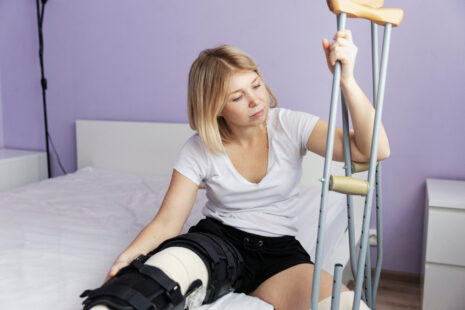Knee pain is a common ailment affecting people of all ages, often disrupting daily activities and lowering the quality of life. Whether it’s due to injury, arthritis, or overuse, finding quick relief is crucial. This post outlines effective methods to alleviate knee pain swiftly, ensuring you can get back on your feet as soon as possible.
Rest and Ice – The First Line of Defense
The initial step in combating knee pain is to give your knee some rest. Avoid activities that exacerbate the pain, such as running or heavy lifting. Instead, opt for low-impact exercises like swimming or cycling once the pain starts to subside.
Applying ice to the affected area can also provide immediate relief. Ice helps reduce inflammation and numbs the surrounding nerves, decreasing pain. Use an ice pack wrapped in a cloth to avoid direct skin contact and apply it for 15-20 minutes every few hours during the first couple of days after the pain starts.
Elevate and Compress for Swelling
Elevation helps reduce swelling by encouraging fluid drainage away from the knee area. When resting, place your leg on pillows to keep it elevated above your heart level. This position not only aids in reducing swelling but also contributes to pain relief.
Compression with a knee brace or wrap can further support the knee and control swelling. Ensure the wrap is snug but not too tight to prevent circulation issues.
Over-the-Counter Medication: A Temporary Solution
For immediate pain relief, over-the-counter (OTC) pain relievers like ibuprofen or acetaminophen can be effective. These medications also help in reducing inflammation. Nevertheless, they should be used sparingly and only as a temporary measure. Always follow the recommended dosage and consult with a healthcare provider if you plan to use them for an extended period.
Stretching and Strengthening Exercises
Gentle stretching and strengthening exercises can help alleviate knee pain by improving flexibility and building muscle support around the knee. Focus on exercises that target the quadriceps, hamstrings, and calves. It’s necessary to start slowly and increase intensity gradually to avoid further strain. Consulting with a physical therapist to get a tailored exercise plan can be very beneficial.
Heat Therapy for Muscle Relaxation
After the initial swelling has gone down, applying heat can help relax and loosen tissues, thereby reducing pain. Use a warm towel or a heating pad on the knee for 15-20 minutes at a time. Avoid heat therapy if you have swelling, as it can worsen the condition.
Seek Professional Help
If knee pain persists despite these immediate measures, it’s crucial to seek professional advice. A healthcare provider can offer a proper diagnosis and recommend treatment options, which may include physical therapy, prescription medications, or in some cases, surgery.
Conclusion
Knee pain can be debilitating, but with the right approach, you can find relief quickly. While these tips can provide immediate pain reduction, addressing the underlying cause of your knee pain is essential for long-term relief. Always consult with a healthcare professional for a comprehensive treatment plan tailored to your specific needs.
Finding quick relief from knee pain is not only about immediate measures but also about understanding and treating the root cause of the discomfort. Stay proactive in your approach and seek professional advice when necessary to ensure your knees remain healthy and pain-free.




